If your garden is anything like mine, there are still plenty of fresh tomatoes to enjoy before the chill of fall settles in. No garden? Head out to your local produce stand and sample the heirloom varieties that are becoming popular. Why not have a simple TOMATO SALAD for lunch or dinner? Eat them alone or with some crisp cucumber slices.
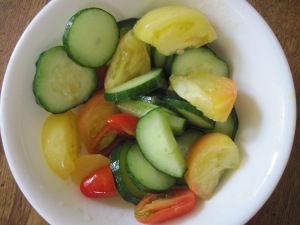 Add just a drizzle of olive oil, salt and basil leaves (if desired). I like it at room temperature to get the best flavor from the tomatoes. You can also dice them and make a fresh SALSA by adding diced onion, diced green peppers (it’s up to you how hot you want them to be), and some chopped cilantro.
Add just a drizzle of olive oil, salt and basil leaves (if desired). I like it at room temperature to get the best flavor from the tomatoes. You can also dice them and make a fresh SALSA by adding diced onion, diced green peppers (it’s up to you how hot you want them to be), and some chopped cilantro.
Celebrate nature’s bounty and enjoy TOMATOES!


Today’s post comes through the courtesy and expertise of Shiela Fuller.
If you started a backyard garden in May, odds are you’ve encountered a few insects in your plot by August. Some are peskier than others. The good bugs arrive right along with the bad, so it is helpful to know the difference.
Before you head off to your local garden supply to buy your pest eradicator, it’s best to identify your pest so you know exactly what you are annihilating. Then before you go, take another moment to research homemade, nontoxic pest controls. They are cheap to make, safer for you to apply, and a healthier choice for the environment. Some commercial products will also kill the good bugs as well as the bad.
What have you planted in your garden and what are the most common pests?
• TOMATOES.
Backyard tomato plants attract a wide variety of bad pests. Most you can pick off by hand and eliminate the need for any spray. The tomato hornworm is a common pest. They start out small and may go unnoticed until you see large areas of plant chewed away. Or you see the telltale peppercorn – like droppings they deposit on the plant leaves. They are green with lighter green shaped “v” markings and a single “horn” poking off the end of its body. Occasionally, you will find white rice shaped eggs attached to the hornworms body. They are the parasitic eggs of a good pest. The eggs suck nutrients out of the hornworm. It dies and the braconid wasp lives on.
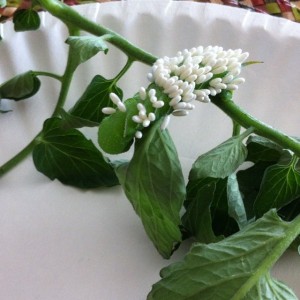
tomato hornworm
• PEPPERS.
Pesticide spray is rarely needed for the pepper plant.
•GREENS.
If you see tiny holes in the leaves of your lovely greens, the flea beetle is most likely the culprit. They won’t usually destroy your plant and you will probably have sufficient supply, even if you have shared your greens with a beetle. Just wash and eat.
• POTATOES.
We love our potatoes and so does the Colorado potato beetle. The peskiest of the pests. If you decide to grow your own potatoes, you will become an expert inspector. It will be imperative that your plants are inspected twice a day. The potato beetle is prolific and the larvae, numerous. Begin by checking for the yellow eggs laid underneath the plant leaf. Remove the eggs. Dispose of them. Unfortunately, you will miss eggs and they will hatch. Numerous little specks of brown will begin to demolish your plant. Find and remove them. If you miss them they will quickly grow into reddish, slug like creatures. Pick them off. At every stage, they will eat your plant down till all that is left is a twig. Remain diligent in your search for potato beetle eggs and larva. Homegrown potatoes are worth it.
• HERBS.
Most herbs are bad pest free. In fact, many are planted to do just the opposite, ward off the bad. However, important to note is that dill and parsley, attract the black swallowtail butterfly. It may be difficult to find the tiny pearlized eggs, but you may find the droppings or the black, prickled larvae eating your precious herbs. They are capable of devouring the entire plant, so always plant enough for all to enjoy.
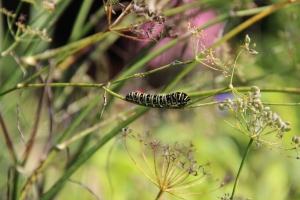
swallowtail caterpillar courtesy of Mary Braccilli
How Do You Attract the Good Insects?
Food, shelter, and water are necessary to encourage and keep the good insects in your garden.
• LADYBUGS
Plant herbs like chives or cilantro, and cosmos flowers to attract the ladybugs.
• PRAYING MANTIS
Raspberry, yarrow and fennel attract praying mantis.
• SPIDERS
The argiope is a large, harmless spider we should be thankful to see in our garden. With its spectacular coloring and circled web with zig zag stitching, it is a treasure to behold.
Food for good insects comes in the form of the bad insects that arrive in your garden. Provide daytime shelter for the good insects; low lying thyme or oregano offer good hiding places. Offer them a shallow tin of water and encourage them to make your garden their home.
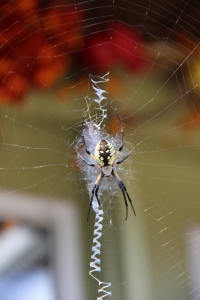
garden spider
Refrain from using insecticides/pesticides in your home garden. These products will actually keep the good bugs away from your garden. They are not good for the health of the insect. Or yours.
Shiela Fuller has been a Cornell University Project Feeder Watch participant for many years and an avid birder since 1988. Currently, she enjoys writing picture books, yoga, chicken raising, wildlife photography, and is the legacy keeper for her family.


I love all the fresh fruit that’s available this time of year. Every trip to the grocery or farmer’s market is an olfactory and visual delight as summer fruits abound. Why not take advantage of the color and variety and make your own fruit salad to have as a snack or for a refreshing dessert at the next barbeque.
For my fruit salad, I used peaches, kiwi, cherries, and blueberries. You can add grapes, cantaloupe, watermelon, pineapple or raspberries. Think multi-colored and you’re sure to have a winning combination. You can sprinkle unsweetened coconut on top or even some homemade granola if you want to add some crunch. Don’t be afraid to try new combinations. 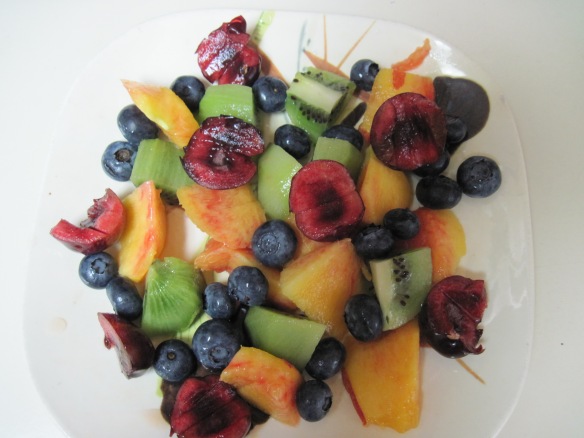 It’s all delicious!
It’s all delicious!


My fellow writer and occasional visitor to this blog, Shiela Fuller is back with her wonderful post on how to raise your own free range chickens. Here’s Shiela:
Long before there were confined feeding animal operations (CAFO), people raised egg laying chickens in their backyards. As the inhumane treatment of mass produced farm animals for food becomes widely recognized, more individuals are turning to traditions of the past and again raising egg layers for their own use.
The instructions that follow for raising chickens are easy, but these are live animals that require care and supervision just as domestic animals do.
DOES YOUR MUNICIPALITY ALLOW FARM ANIMALS?
The prospective chicken owner must first research and determine if their municipality has regulations against the keeping of farm animals. If not, begin the search for a hatchery.
LOCATE YOUR NEAREST HATCHERY: Your two day old chicks will most likely be shipped by U.S. mail. A decreased distance from home to hatchery means your chicks will arrive quicker, less stressed and in better condition. Don’t be tempted to purchase the cute chicks you see for sale at your local farm and garden store. All chicks look alike at two days old, but at four months your cute chicks could grow up to look like this: 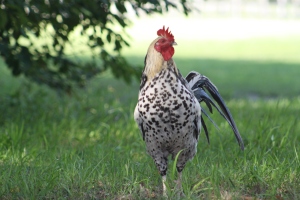
WHEN TO ORDER
Plan to have your chicks arrive late spring/early summer. Order an egg laying breed such as the Rhode
Island Red or a mixed breed. Order your chicks with their beaks intact. You will have to ask for this as
hatcheries raise chicks by the tens of thousands and debeaking is done routinely as a matter of safety
and well-being for the large numbers that are kept in confinement.
HOW MANY TO ORDER: Order the number of chicks dependent on your available space. If your adult hens will free range on an acre, 15 chicks will be suitable. If you are limited to keeping your adult hens in a backyard enclosure, six chicks will be sufficient. Unless you plan to go into the business of selling eggs, 15 egg layers will create a sufficient supply. Once egg laying begins, hens routinely lay one egg per day for up to two years. They lay more productively in summer than winter, too. This is because egg laying is dependent on the number of daylight hours.
YOU’VE PLACED THE ORDER. You now have a delivery date. Call your post office and give them the information and your phone number. They will call you as soon as your chicks arrive.
WHILE YOU’RE WAITING: Assemble the things you will need to house your new arrivals. If you don’t have any of these items on hand or cannot borrow, purchase:
a large plastic tub with sides high enough that chicks cannot jump out, (for extra security a sheet of screen over the top will also help keep the chicks secure), a bag of cedar shavings, a heat lamp with a secure fastener, waterer, organic chicken crumbles.
Set up your chick’s housing in the location you have chosen. A warm kitchen, an out of the way mud room, or even the garage will be suitable. Place about three inches of cedar shavings in the bottom of the tub, securely fasten the heat lamp about 20 inches above the floor of the chick’s enclosure, put fresh cool water in the waterer, and offer plenty of crumbles.
THE CHICKS HAVE ARRIVED: The chicks will arrive in a ventilated cardboard box. Pick them up promptly from the post office and settle them into their new home. 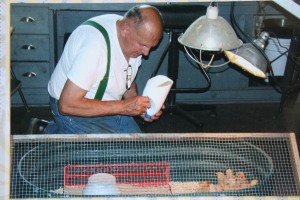
Pick each chick up individually and place them in their warm , draft free environment. Dip each chick’s
beak quickly in the water to induce drinking. This will also help “freshen” any chick that may have
arrived in an overstressed condition. Keep the food bowl filled as chicks eat constantly, and clean, as
chicks do not discriminate between the toilet area and feeding area. Pay attention to the comfort of the newly acquired chicks. Use the huddle indicator: If they huddle together, your lamp is too far from the chicks; if the chicks huddle in the corners, away from the heat source, the lamp is too close.
DAILY ROUTINE:
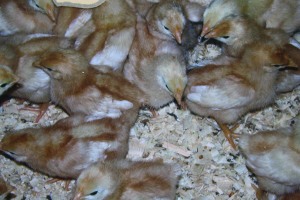 Maintain a bed of clean, dry shavings daily as it will become soiled from spilled water, food and excrement. The chicks will grow quickly and may need to be moved to a larger indoor container, such as a large dog crate. Use your judgement. By this time, you will feel accustomed to taking care of your chicks and will know when they are over crowed and need larger housing.
Maintain a bed of clean, dry shavings daily as it will become soiled from spilled water, food and excrement. The chicks will grow quickly and may need to be moved to a larger indoor container, such as a large dog crate. Use your judgement. By this time, you will feel accustomed to taking care of your chicks and will know when they are over crowed and need larger housing.
MOVING DAY: By about six weeks of age the chicks will have most of their feathers and if the outside temperature is warm, they can be moved to their outdoor location.
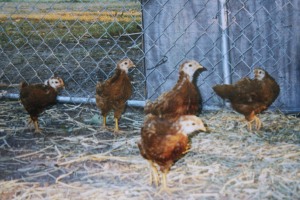 Much care needs to be taken as to the safety of your flock. Opportunistic predators such as snakes, hawks, owls, and foxes love captive prey. Even chicks that will eventually free range will need a place for safe keeping at night time.
Much care needs to be taken as to the safety of your flock. Opportunistic predators such as snakes, hawks, owls, and foxes love captive prey. Even chicks that will eventually free range will need a place for safe keeping at night time.
OUTDOOR HABITAT: For a small flock of confined hens or a free range flock that need a safe keeping place,a suitable arrangement can be made from the following items:
an 10 x 10 outdoor dog kennel, or larger; an outdoor dog house, plastic netting for a cover, fresh hay for filling house and box, egg laying box, perching area, organic egg layer pellets and water bowl.
Dig an area 10 x 10 in diameter and drop your kennel into the earth. This aids in keeping the digging predators, like foxes from gaining entrance and eating your hens. Cover the enclosure with netting to keep out the flying predators. After four months of age, the hens will have grown too large for snakes to consume, so they become less of a problem.
The egg laying boxes, feed bowls, and waterer, the perching area below. 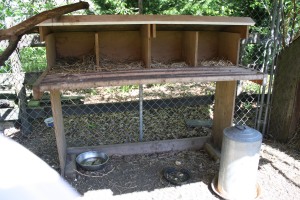
The housing is made from a dog box and plastic cover.
Congratulations! You have successfully raised chicks to egg laying hens. You will make mistakes and learn more as you move along in your chicken adventure. Some additional facts:
—Chickens will eat much more than crumbles and pellets. Offer them seeds, produce and vegetable leftovers, both cooked and uncooked. Free range hens will also consume baby birds, mice and toads. Chickens have individual food preferences.
—Once your free range chickens are accustomed to their new outdoor accommodations, free them in the morning and near dusk they will (they should) return to the enclosure to be locked in for safe keeping at night.
—A rooster is not necessary for egg layer success.
—The chickens will eventually see you as their food source and will run to you upon calling them.
—As was said earlier, snakes are not a problem once your chicks are too large to be consumed, but at some point you may be startled to find one in your hen enclosure:
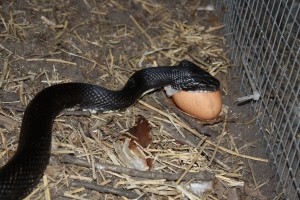 Keep in mind snakes are an important part of the ecosystem. You can spare an egg or two!
Keep in mind snakes are an important part of the ecosystem. You can spare an egg or two!


All these years I’ve heard about the Sugarplum Fairy in the Nutcracker. I’ve read about children dreaming of sugarplums in A VISIT FROM ST. NICHOLAS. Yet I never saw or tasted a real live sugar plum of my own. Until today.
When I stopped at my local farmer’s market, there on the stand, next to sweet cherries and peaches were these little gems. If you get a chance to sample these bite-sized bits of plum heaven, do so. You won’t be sorry.
They are plum delicious! Sorry…I couldn’t help myself. 


 Add just a drizzle of olive oil, salt and basil leaves (if desired). I like it at room temperature to get the best flavor from the tomatoes. You can also dice them and make a fresh SALSA by adding diced onion, diced green peppers (it’s up to you how hot you want them to be), and some chopped cilantro.
Add just a drizzle of olive oil, salt and basil leaves (if desired). I like it at room temperature to get the best flavor from the tomatoes. You can also dice them and make a fresh SALSA by adding diced onion, diced green peppers (it’s up to you how hot you want them to be), and some chopped cilantro.













My backyard garden has produced a prolific supply of tomatoes this year. I learned to make marinara and salsa – though unfortunately all my cilantro died.
My kids have loved helping in the garden, and our reading about gardening and tomatoes led us to this beautiful picture book called Little Yellow Pear Tomatoes by Demain Elaine Yumei that explores all the kinds of life in the tomato garden. You’d love it. http://www.goodreads.com/book/show/24864.Little_Yellow_Pear_Tomatoes
The book sounds wonderful. I’ve added it to my TBR list! Thanks for recommending it Katey…it’s always good to hear from you.